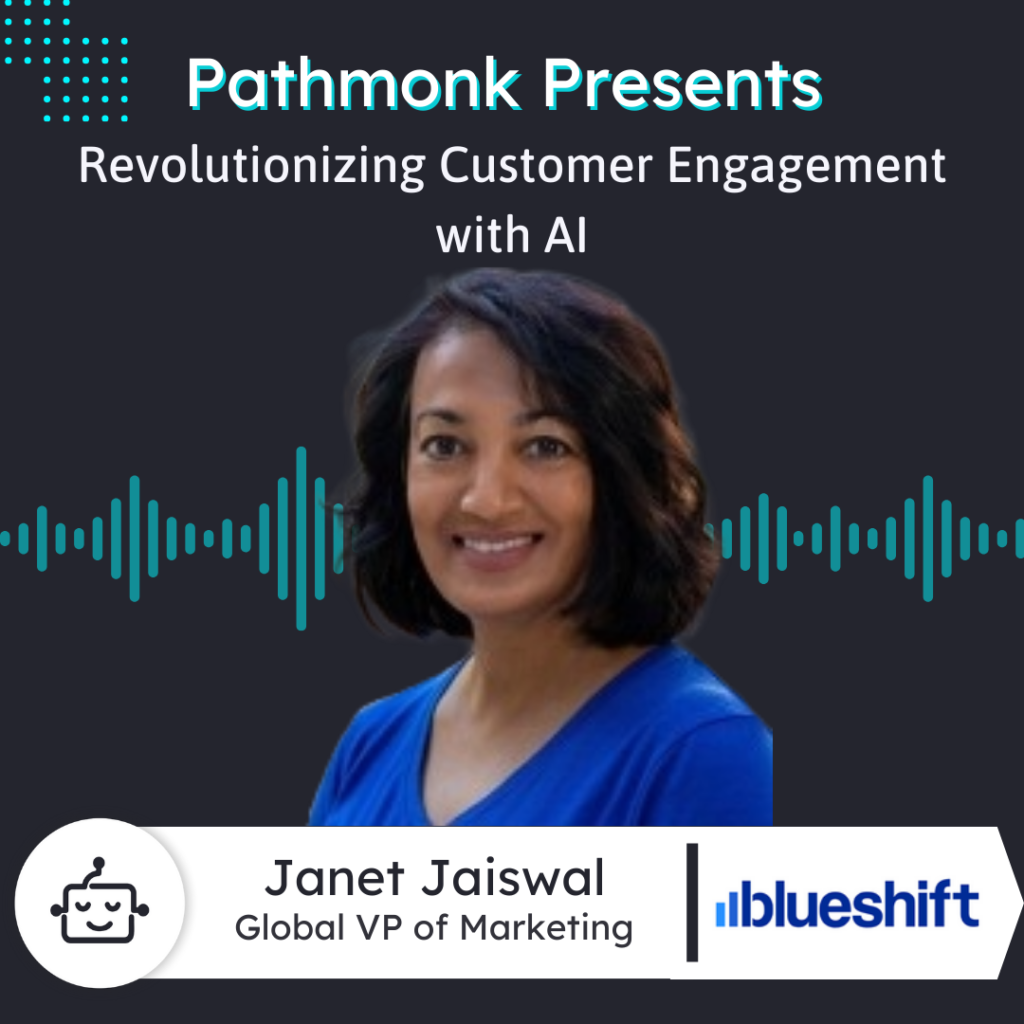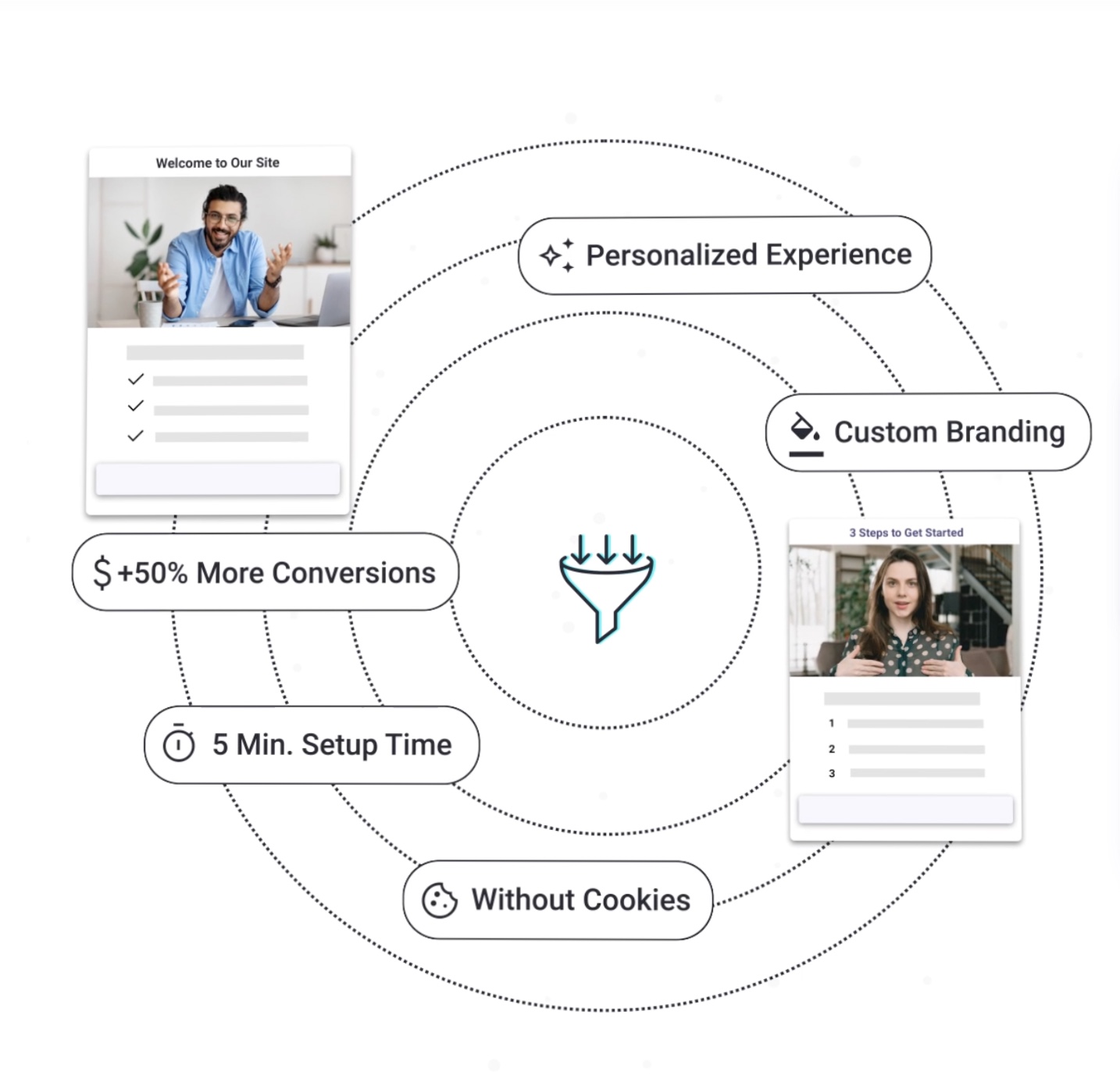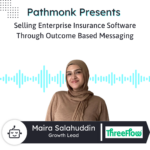
Introduction
Join us as we welcome Janet Jaiswal, VP of Marketing at Blueshift, a San Francisco-based company revolutionizing customer engagement through AI-powered technology.
In this insightful episode, Janet shares how Blueshift’s intelligent customer engagement platform unifies and activates customer data across all channels, enabling brands to deliver personalized experiences in real-time. Learn about the challenges of implementing one-to-one marketing at scale and how Blueshift’s AI models make sophisticated capabilities accessible to everyday marketers.
Janet also offers valuable tips on website lead generation and discusses her role as a marketing leader, providing a wealth of knowledge for B2B marketers looking to enhance their strategies and drive growth.
More Sales From Your Website With AI
Personalized interactions based on your users' behaviour to get +50% more conversions.

Ernesto Quezada: Pathmonk is the intelligent tool for website lead generation. With increasing online competition, over 98% of website visitors don’t convert. The ability to successfully show your value proposition and support visitors in their buying journey separates you from the competition online. Pathmonk qualifies and converts leads on your website by figuring out where they are in the buying journey and influencing them in key decision moments. With relevant micro experiences like case studies, intro videos, and much more, stay relevant to your visitors and increase conversions by 50%. Add Pathmonk to your website in seconds. Let the AI do all the work and get access to 50% more qualified leads while you keep doing marketing and sales as usual. Check us out on pathmonk.com. Welcome to today’s episode. Let’s talk about today’s guest. We have Janet from Blueshift, VP of Marketing with them. How are you doing today, Janet?
Janet Jaiswal: Doing great. How about you?
Ernesto: I’m doing great, thank you so much for being on with us today. I’m glad that we were able to connect. You have a lot of experience in the marketing world. Definitely love having you on today’s episode.
Janet: Awesome. Let’s do this.
Ernesto: Yeah. Well, let’s kick it off then. I’m sure our listeners are tuning in, wondering what Blueshift is all about. So, Janet, in your own words, tell us a little bit more.
Janet: Sure. Blueshift is a San Francisco-based company. We help brands automate and personalize engagement across every marketing channel, whether that’s online or offline. The Blueshift Intelligent Customer Engagement Platform utilizes patented AI technology. We use that to unify, inform, and activate the fullness of customer data across all channels and applications. Essentially, we provide a customer data platform and a cross-channel marketing hub, integrated, all in one place. This way, brands like B2C companies have all the tools they need to deliver one-to-one experiences in real-time across the entire customer journey.
One thing I will add is, we’ve been recognized in Gartner’s Magic Quadrant for CDP as well as a leader in GigaOm’s Radar for CDPs. I’m proud to say that we’ve been part of the Deloitte Technology Fast 500 list in 2020, 2021, and 2022 as one of the fastest-growing companies in North America. Given the pandemic and the economic turmoil, we’re pretty proud of that.
Ernesto: Definitely. You should be proud of that, right? Those are accolades that everybody would wish they could have. Awesome to hear that from Blueshift. And so that way our listeners, Janet, can get a good understanding of Blueshift, what would you say is the key problem that you guys like to solve for clients?
Janet: The problem is that we mostly serve B2C brands across multiple industries on a global basis. The problem that we solve is enabling marketers at these companies to interact with their customers on a one-to-one basis in a scalable manner. That means giving marketers insights into their customers’ wants and needs so the brand can serve up the right content, maybe a product recommendation or information, at the right time, on the appropriate channel, at a time they believe the customer will be responsive. It sounds straightforward, intellectually speaking, but it’s incredibly difficult to implement in reality. Data is everywhere, and it’s difficult to make sense of it.
That’s where our AI models come in because they help make accurate predictions, which typically require specialized skills and technology that aren’t always within the reach of a typical marketer. We take very sophisticated and complex capabilities and put them into the hands of everyday marketers who don’t need a Ph.D. in data science, for example.
Ernesto: Definitely, and that’s super important, right? If they could do that, that would be great. So, what would you say is your vertical segment? I know you guys work with carparts.com, LendingTree, Discovery+, so is there a segment, an ideal ICP for Blueshift?
Janet: It is a horizontal platform. Like you mentioned, we serve customers in retail, media, and personal finance, as well as industries like media and publications—for example, U.S. News is a customer. So I can’t say we’re specific in that ICP. We do tend to target mid to large enterprise-sized customers. For smaller companies, usually, email marketing or a marketing automation platform is sufficient. But when you start to get into high volumes of customers, typically B2C companies, it becomes really hard to market to them.
We find marketers usually create segments and say, “Okay, if you belong to this segment, you all get the same treatment.” What we enable is one-to-one interaction, and it’s done in real-time as a customer browses through the website or app. Our models are recalculating, saying, “Oh, this person is showing an affinity towards this,” or “They’re leaning towards certain colors.” We serve them information or recommendations to help them progress through the journey in real-time. That’s what’s really cool; it is indeed one-to-one marketing. As fellow marketers, we know that’s the holy grail, right? The more relevant and personalized the information is at the right time, the more likely that prospect or consumer is to respond to that brand.
Ernesto: I would definitely agree with you on that. So, how would somebody usually find out about Blueshift? Say, if I was in the retail industry or e-commerce, how would I find out about Blueshift? Is there a top client acquisition channel for you guys?
Janet: We have both inbound and outbound, but the ones that work best are organic search, which is all about having good content and good SEO practices, as well as paid search. But really, it’s mostly organic search, analyst relations—many of our buyers go to analysts to create their short list, so that’s where they find us—and partners. We have some amazing partners that are marketing agencies, technology partners like AWS, and so forth. These are folks that are already trusted, where a company already has a relationship, so they tend to bring us into deals, if you will.
A surprising number of people will try our free CDP. While we don’t target smaller companies, which is typically where free products come in, we made our CDP, our customer data platform, free because we wanted companies to see how easy it is to use and how straightforward something like a CDP can be. And if you know anything about CDPs, they are not easy to use and often require IT departments to get involved, with a lot of wrestling. We made that free on purpose because we wanted people to try it out hands-on. We’ve been able to use it in 15 minutes, so we think our customers will find it easy to use as well.
Ernesto: That’s really nice to hear.
Janet: Thank you.
Ernesto: So, that way, our listeners can go ahead and try that out. They can always visit you at blueshift.com. What role does the website play in client acquisition?
Janet: Our website brings a good number of visitors through organic search, which I mentioned earlier, and that’s great. It also allows our visitors to do some research on their own, learn about the problems we solve, and kick the tires a little bit. My viewpoint is that the website is important for all marketers and should play a large role in customer acquisition. If you think about it, it’s essentially the storefront of the company, right? When they haven’t met us in person, they don’t really know what we’re about. The website is usually where they’ll go to get a first impression of the company, what they’re about, who they serve, who their customers are, etc. That said, our website is a living, breathing thing, and it’s constantly undergoing change because it is that important to us.
Ernesto: Perfect, awesome. So, is there any tips or methods that you would recommend to our listeners as far as website lead generation?
Janet: Yes. Now we’re hitting an area where I’m very passionate. A high-converting website typically has five key things you have to do right. First is the messaging. You have to know who your audience is, what their pain points are, and then tie your solution into how you can address those pain points. If you don’t get the message right, they’ll think, “This isn’t for me,” or if it’s too high level, they might not understand what you’re providing and whether they need it. Messaging is very, very important. You have to do your homework, have buyer personas, talk to customers, and really understand a day in the life of a typical buyer.
Second is what I call the art of marketing—the design, the color, the copy, the words you use, how many you use. It should be appropriate for the type of business you are and the customers you’re targeting. If it’s casual and brightly colored, maybe you’re trying to appeal to consumers. If it has muted color tones and the style of writing is very business-like, you might be focusing on enterprise buyers. These elements help form an impression in your visitor’s mind of who you are and what you provide.
Once you’ve got those things, you really need to put in an A/B testing tool to see what content, messaging, call-to-action buttons, etc., resonate the best. To develop the message, I recommend talking to your customers, doing research, and there are also providers out there that will test with your target audience. Once you have that, use your A/B testing tool to see which one works the best.
Next, put together a well-defined SEO strategy. This is where you narrow down the keywords you want to optimize your site for and create content that educates and places well in search results for those keywords. Then tie in your SEM strategy—your paid ads, paid search, retargeting, etc.—so that the two are consistent with each other and complementary, not fighting against each other.
Assuming you’ve done those first four steps, you should start to get a decent amount of traffic on your website. At that point, you can add more tools to improve your website performance and help convert more of those visitors into potential prospects. Examples would be conversion rate optimization, where you optimize every landing page, form, header, etc. Eventually, you can add personalization software that will personalize a message to each individual, like what we provide, or you can do it in segments, which is an easier thing to start with—personalize your message to segments like by industry, size, geography, etc. Those are the five key steps to take your website performance to the next level.
Ernesto: Definitely important. I mean, I have to ask, have you ever thought about putting that into a book? I mean, those five steps could be a book!
Janet: No, no. There are a ton of people smarter than me who have already done that. I just find this is what’s tried and true over the last 20-plus years that I’ve been doing B2B marketing.
Ernesto: Well, you’ve got a couple of accolades. I wouldn’t be surprised if at one point you decide to write it down. You were named one of the top 100 B2B marketers last year, so that’s always nice to have, right?
Janet: Yeah, thank you.
Ernesto: Let’s switch gears a little bit, Janet, and talk about you as a leader. You are the VP of Marketing at Blueshift. What are some key tasks you focus on in your day-to-day work?
Janet: Oh gosh, my day-to-day does vary, but I can tell you I focus on setting the overall strategy and then working with my team leads to create that roadmap of what we want to achieve quarter by quarter to support that overall strategy. Once the strategy is set, my day-to-day is really about incorporating best practices in each area—whether that’s demand gen, content marketing, email marketing, website, all of the typical functions. I also take on projects that no one else either has time for or that involve connecting the dots.
A good chunk of my work is always collaborating with sales and customer success. We’re all part of the same go-to-market function, and the three of us are very interdependent. If I’m not collaborating effectively with sales and customer success, I’m doing something wrong. So, I tend to spend more time making sure the three of us are aligned, so marketing isn’t targeting an industry that sales isn’t even aware of or interested in. And, of course, as you acquire those customers, you don’t want it to be a surprise to customer success because they have to be prepared and well-versed on who we’re targeting and what types of customers we’re getting. So, collaboration is very important beyond the day-to-day functioning of the marketing department itself.
Ernesto: Definitely important. It sounds like you have a full plate there, Janet. In the in-between time, how do you stay up to date with all the news and marketing trends? Is there a preferred channel that you like to stay up to date with?
Janet: There are many, but one of my favorites is that there are several CMO networks accessible through Slack. One is CMO Coffee Talk, and another is CMO Huddles, which is B2B marketing-focused. Both are open to the senior-most member of the marketing department, and it’s a great source of knowledge, recommendations, advice, and even a place to vent when I need it. We all have those days when we want to talk to a fellow marketer who’s been in our shoes. It’s just nice to have these communities to go to for all those things. I’m sure there are tons of other sources out there, but those are my two go-tos. I belong to several others that I also frequent, though not as often.
Ernesto: Great, thank you so much for sharing that. I’ve heard a lot of CMOs mention Coffee Talk, so that’s a good one for our listeners. Let’s jump into our next section then, Janet, which is our rapid-fire question round. Are you ready for them?
Janet: Sure.
Ernesto: Awesome. First off then, Janet, what is the last book that you read?
Janet: Ooh, it’s a book by a gentleman named Matt Lerner. He’s a talented marketer, and he and I used to work together at PayPal. His book is called “Growth Levers, and How to Find Them.” It’s a very short, easy-to-digest book, but it’s a great way to go back to the fundamentals and basics and make sure you’re approaching your marketing with a bit of a guerrilla marketing mindset. But he makes it easy to understand and digest. I strongly recommend the book; it’s a very fast read, probably 90 pages, but a really good book.
Ernesto: Definitely. That’s a good read for our listeners. Next up then, Janet, if there were no boundaries in technology, what would be the one thing you would want to have fixed for your role as a marketer today?
Janet: I’ve got a simple one. I would love to have my entire tech stack integrated. I don’t think there are solutions out there that do some of it, but not all of it. I would love to have all the data flowing from one end to another because marketers have people interacting with us through many channels. You don’t want to have to keep reconciling an email address from an email subscription with a Twitter profile where it’s not the email address but some other name. Trying to take all those different profiles and put them together so that I understand it’s one person—that’s really hard to do. Data is the marketer’s lifeblood. By being able to measure what’s working and what’s not, and how well it’s working, we can improve. Bringing all that data together helps us make better decisions and be better marketers. It’s a simple request, but in reality, it’s not that simple.
Ernesto: No, I mean, sure. The way technology seems to be going, we’ll probably see it sooner than later, hopefully.
Janet: Well, I mean, there are 8,000 technologies out there as part of the Martech stack, so the sooner someone gets to it, the more money they’ll make.
Ernesto: And there will be more, right?
Janet: Oh yeah, it’s growing for sure.
Ernesto: Next, Janet, if there’s one repetitive task that you could automate, what would that be?
Janet: Setting up meetings—just ratifying multiple dates and times that work with various parties is such a huge waste of time. I honestly miss my admin assistant. I currently don’t have one, so I have to schedule everything on my own. Tools like Calendly help, but it’s never the same, and just trying to get everybody onto one page is hard, and it takes a lot of time. Why are we spending that much time setting up meetings?
Ernesto: Exactly. And that’s with clients, right? It’s sometimes difficult, and within colleagues, too. It’s like, “Hey, well, I’m busy.” “Hey, can we do it here?” “I can’t do it at that time.” So, definitely, I think there’s still a lot of room for improvement in that area.
Janet: Yeah, especially if you’re working with people in different geographies and time zones. It just compounds the problem.
Ernesto: Exactly. I mean, here on the podcast, I get people from all over the world, so sometimes it’s like, “Okay, I can make it.” Other times, it’s like, “I can’t.” And it’s just back and forth trying to arrange that. So, definitely, if someone’s out there thinking about it, that would be really great.
Janet: Yeah.
Ernesto: Awesome. And, well, lastly, Janet, I mean, like you mentioned, you have 20-plus years of experience in B2B SaaS companies, from startups to industry giants. But what is that one piece of advice you would give yourself if you were to restart your journey as a marketer today?
Janet: Restart my journey? What I would say is, find an industry or domain that you like and stick to it as early as you can in your career. As you become more and more senior in your role, you want to establish expertise within marketing because that helps you provide more thought leadership to help you progress and grow. That could be figuring out if you want to do B2C marketing or B2B. The two are very different. Or it could be by industry or by the size of the company—public, private, small, large, whatever. I did establish that focus on B2B marketing, but I would say later in my career than I wanted to, still enjoying it, though, so can’t complain. But that’s the advice I would give to folks. As soon as you figure out what you like, stay in that area of focus and continue to progress.
Ernesto: Some great advice there. I do appreciate that, Janet. Well, we are coming to the end of the show today, but before we do end, I do want to give you the last word. Say someone forgets everything about the interview today. What is that one thing they should remember about Blueshift?
Janet: I would say Blueshift empowers marketers who don’t have an army of people to do something that’s incredibly sophisticated, that used to be reserved for just the largest companies with marketing teams of hundreds. We allow a lot of our B2B companies to do a lot of that without an army of marketers—that whole one-to-one personalization. It’s so gratifying to see customers who are like, “Oh my God, I did this, and I got promoted.” We love hearing stories like that and look forward to creating more heroes that way.
Ernesto: Definitely important. Awesome. Thank you so much for sharing that with us. To our listeners, you can always check them out at blueshift.com. Cross-channel marketing powered by unified data. Janet, thank you so much for being on with us today. To our listeners, thank you so much for tuning in, and I’m looking forward to our next episode at Pathmonk Presents. Thanks a lot, Janet.
Janet: You’re welcome. Thank you.











